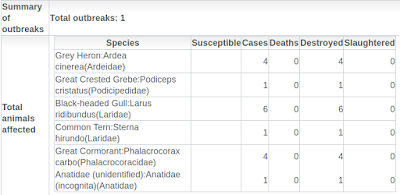#11,478
Even under the best of circumstances, getting solid data on the carriage of HPAI viruses in wild and migratory birds can be difficult. Some birds carry these viruses without symptoms, while others may sicken or die unobserved in the wild.
While there are some surveillance programs in place, often the detection of HPAI in wild birds is more the result of happenstance than design.
It is for that reason that more than a decade after the great diaspora of H5N1 from Southeast Asia to Europe, Africa, and the Middle East there are still heated arguments over the role of migratory birds in the spread of HPAI (see Revisiting The Migratory Bird Debate).
Unlike in 2015, we've seen relatively few reports coming from Europe, Russia, and Asia this year.
Today, however, we have an OIE report from Russia, which lists a number of bird species taken by hunters earlier this month in and around Ubsu-Nur Lake that have tested positive for HPAI H5.
While the HPAI H5 clade is identified (Asian HPAI virus H5 lineage A/Guandong/1/96, clade 2.3.4.4), the full subtype is not provided.
Clade 2.3.4.4 is commonly found in avian H5N1, H5N8, H5N2 and H5N6. Both H5N1 and H5N8 have previously been reported from Russia.
A total of 17 birds tested positive. While H5N1 is the most likely culprit, hopefully there will be additional information forthcoming on the subtype.
The OIE report follows.
Source of the outbreak(s) or origin of infection
Contact with wild species
Epidemiological comments
During the active monitoring of the ornithofauna in the surroundings of Ubsu-Nur Lake, a few wild birds were shot. Genome of H5 avian influenza virus was detected in 17 samples from carcasses of birds [black-headed gull (Larus ridibundus), grey heron (Ardea cinerea), common tern (Sterna hirundo), great crested grebe (Podiceps cristatus), great cormorant (Phalacrocorax carbo), duck (Anatidae)]. Sequence analysis of the isolates showed that they belonged to the Asian HPAI virus H5 lineage A/Guandong/1/96, clade 2.3.4.4.


